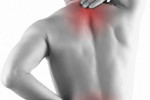 Through our senses, our bodies take in information from the world around us. A receptor in your joints, muscles, or skin picks up a signal that is sent by the nerves to the spinal cord to the brain, which interprets and sends a signal back to the body to respond accordingly to the stimuli. The nervous system is able to adapt, defend, and keep us healthy when this cycle runs smoothly. If this cycle isn’t in balance, the result can be chronic pain.
Through our senses, our bodies take in information from the world around us. A receptor in your joints, muscles, or skin picks up a signal that is sent by the nerves to the spinal cord to the brain, which interprets and sends a signal back to the body to respond accordingly to the stimuli. The nervous system is able to adapt, defend, and keep us healthy when this cycle runs smoothly. If this cycle isn’t in balance, the result can be chronic pain.
There are two types of receptors that take in signals from the outside world and send them to the brain for interpretation. The first are pain receptors called nociceptors that detect potential injury and send a warning signal to the brain. The second type are called mechanoreceptors and they are activated by movement, stretch and pressure.
In a healthy body, there is a balance between these two signals. The more dominant signals determine the functional state of the nervous system. The lines that send the signals have different sizes, and the large fibers that send the mechanoreceptor signals inhibit the small fibers that send the pain signals. The slower pain signals are blocked from getting sent to the brain for interpretation. When the body’s joints and tissues are aligned and moving well under the stimulation of gravity, the “pain gate” is closed. When there is a problem, like chemical stress from an injury, or mechanical stress from an irritated joint, the pain gate opens up.
Restricted joint mobility causes decreased firing of mechanoreceptors and increased firing of warning signals from nociceptors. Chiropractors have many different styles of practice and techniques, but all find and treat areas of reduced mobility to remove interference from the body’s lines of communication so the it can function at its optimal level, heal, protect, adapt, and self-regulate.
When there is not a balance between the pain signals and the movement signals, this is the difference between the body being in a state of protection versus a state in which it can prosper. For example, when joints are not moving properly and a warning signal is sent to the brain, one way the brain responds is to send a signal back for the muscles to spasm in an attempt to stabilize the joint and protect the body. This is good if you’re arm is being pulled and your muscles activate to protect you from tearing a ligament, but very bad day to day if you have a malpositioned joint in your neck.
When the body is more tuned in to nociceptive pain signals than mechanoreceptor signals, this also creates a stress response in the body that can become chronic. The posture of someone in a stress state is forward-bending, flexing their muscles and rolling their shoulders forward to protect the vital parts on the front of the body from an attack. This is why the posture of someone in chronic pain is often this hunched forward posture, with the muscles of the shoulders and back spasmed and straining to pull the body back into it’s proper position in alignment under gravity. The effects of chronic stress is a topic for another day, but this is how chiropractic helps control pain by restoring the biomechanical and neural integrity of the joints.

